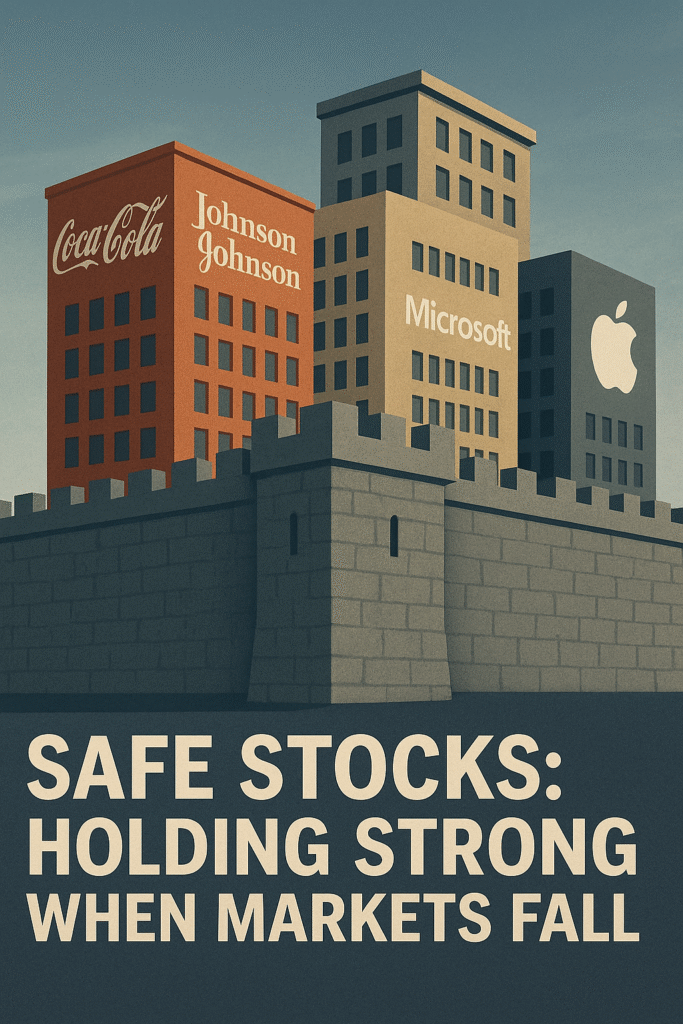The energy story in 2025 is bigger than “oil is up” or “renewables are booming.” Global energy investment is projected to reach a record $3.3 trillion in 2025, with about $2.2 trillion expected to go into clean energy technologies like renewables, grid upgrades, battery storage, and nuclear—compared with roughly $1.1 trillion still headed toward fossil […]
Investing in a Downturn: Why “Safe” Stocks Matter

When markets slam on the brakes, many investors flee to cash or bonds out of fear. The problem: drastic moves often lock in losses and leave you sidelined when markets rebound. A more strategic approach is to tilt part of your equity portfolio toward defensively oriented stocks that tend to hold up better — so you participate in upside, while reducing the damage during the decline.
For educational purposes only, not investment advice. Results may vary, and investing involves risk. Please read our full disclaimer at the end of this article.
In this article, we’ll dig into:
What makes a stock “downturn-safe” Historical performance of defensive stocks Criteria and strategies for selecting safe stocks Sectors and stock ideas for 2025 Risks and caveats to watch Sample portfolio allocations
What Is a “Downturn-Safe” Stock?
A “downturn-safe” stock isn’t one that never falls. Rather, it’s one that declines less than the broader market during stress, maintains cash flow or earnings, and often pays steady dividends—providing ballast to your portfolio. Key features typically include:
Stable or inelastic demand — Strong balance sheet with manageable debt — Durable competitive advantages or regulatory moats — Consistent dividend record (ideally raised for decades) — Reasonable valuation
Historically, defensive stocks have sometimes produced lower upside in bull markets, but their drawdowns tend to be shallower. Over full cycles, that volatility buffer can enhance risk-adjusted returns.
For example, the Dividend Aristocrats (companies that have raised dividends for 25+ years) fell only about 22% during 2008 versus 38% for the S&P 500 (source: Sure Dividend, Dividend Aristocrats historical data).
Why Defensive Stocks Can Outperform in Downturns
Cash flows are more stable – Consumer staples, utilities, and healthcare companies serve basic needs that people continue to buy. Dividends provide a cushion – Regular income can offset price volatility. Valuations compress less – Defensive stocks usually trade at modest multiples, so there is less room for panic-selling revaluations. Rotation flows – When fear rises, money often shifts from high-growth names into “boring but safe” companies.
That said, no sector is immune. For instance, utilities can still suffer when interest rates rise, since higher borrowing costs pressure their balance sheets (source: Investopedia, “How Utilities Are Affected by Interest Rates”).
Zero-Commission Trading
Claim Free Stocks on Webull
Open a Webull account and make your first deposit to unlock bonus stocks. Powerful charts, extended hours, and a sleek app—great for active or casual investors.
Affiliate link, disclosures apply.
Sector Themes and Examples
1. Consumer Staples
These companies sell essentials: food, beverages, hygiene, and cleaning products.
Coca-Cola (KO) – resilient global beverage brand with a long dividend history (source: Investing.com stock data). Church & Dwight (CHD) – maker of Arm & Hammer, Trojan, and other household brands that people continue to buy (source: Investing.com, “Recession-Ready Stocks”). PepsiCo (PEP) – diversified snacks and beverages with pricing power (source: Simply Safe Dividends, “Recession-Proof Stocks”).
Pros: Steady demand, brand loyalty.
Risks: Commodity price spikes can squeeze margins.
2. Healthcare & Pharmaceuticals
Healthcare is non-discretionary.
Johnson & Johnson (JNJ) – diversified healthcare giant with drugs, devices, and consumer products. Pfizer (PFE) – pharmaceuticals with global reach. UnitedHealth Group (UNH) – large insurer with strong cash flows.
Pros: Demand holds up in recessions.
Risks: Patent cliffs, regulation, and litigation.
3. Utilities & Infrastructure
Power, water, and gas bills must be paid.
Duke Energy (DUK) – regulated U.S. utility with electricity and gas operations (source: Investing.com stock data). NextEra Energy (NEE) – combines utility operations with renewables (source: Motley Fool, “Recession-Proof Stocks”). Dominion Energy (D) – electricity and gas provider often cited for stability (source: Nasdaq.com, “Stocks to Own in Recession”). American Water Works (AWK) – largest U.S. water utility, serving essential needs (source: Motley Fool, “Recession-Proof Stocks”).
Automate Your First Step
Start Investing with Your Spare Change
Acorns rounds up your everyday purchases and invests the change automatically—perfect for getting started without overthinking it. Set it, build the habit, and let compounding work for you.
Affiliate link, disclosures apply.
Pros: Predictable earnings, dividends.
Risks: Regulatory changes, capital spending, interest rate exposure (source: Investopedia, “Utilities and Interest Rates”).
4. Dividend Aristocrats
Companies that have raised dividends for 25+ years show resilience across cycles.
Examples include Coca-Cola, Procter & Gamble, and 3M (source: Sure Dividend, “Dividend Aristocrats List”). Data shows this group has smaller drawdowns in recessions but slower gains in bull markets (source: ProShares, “Are Dividend Aristocrats a Bargain?”).
5. Other Defensive Plays
Waste Management (WM) – garbage collection is recession-proof. Telecom firms like Verizon and AT&T – connectivity is a necessity. Midstream energy pipelines – contracted cash flows can provide stability.
Sample Portfolio Mix
Base Allocation: 20–30% in defensives for balance. Cautious Tilt: 40–50% if recession risk is high. Diversification: Spread across staples, healthcare, utilities, and dividend growers.
You can also use ETFs such as NOBL (Dividend Aristocrats ETF) or low-volatility funds for easier exposure (source: Kiplinger, “Best Dividend Stocks You Can Count On”).
Risks and Caveats
Overvaluation risk – safe stocks can get crowded and overpriced. Interest rate risk – utilities and REITs are vulnerable when borrowing costs rise. Regulatory changes – healthcare and utilities face government oversight. Lower upside – defensives may lag during strong recoveries.
Warren Buffett has even warned that utilities are not risk-free, citing issues like wildfire liability (source: Business Insider, “Buffett’s Warning on Utility Stocks”).
Conclusion
No stock is completely “safe” in a downturn. But defensive companies with strong balance sheets, steady demand, and reliable dividends can cushion portfolios and help investors ride out the storm. By mixing staples, healthcare, utilities, and dividend aristocrats, you can lower risk without abandoning equity exposure—and be well-positioned when markets eventually rebound.
The information provided on this article is for educational purposes only and should not be considered financial, investment, or legal advice. Investing involves risk, including the potential loss of principal. Always conduct your own research or consult with a licensed financial advisor before making any investment or financial decisions. ThriveLifeHQ does not guarantee any specific financial outcomes.
Trending Posts On Thrive Life HQ
Top 5 Best US Cities for Retirees in 2025
Retirement is changing fast. The old image of rocking chairs and quiet suburbs is being replaced by active lifestyles, affordable comfort, and access to great healthcare. In 2025, retirees are looking not only for sunshine but also for stability, culture, and connection. Using data on cost of living, healthcare access, housing affordability, and quality of […]
ThriveLifeHQ’s 2025 Holiday Savings Guide
Holiday shopping is bigger, longer, and more digital than ever—which means there are more ways to save if you plan ahead and stack rewards strategically. This guide keeps it simple: practical tactics you can use today, with easy, no-cost tools. 1Cash-Back Apps & Portals You Can Stack Free to Join Start with a cash-back “layer” […]


